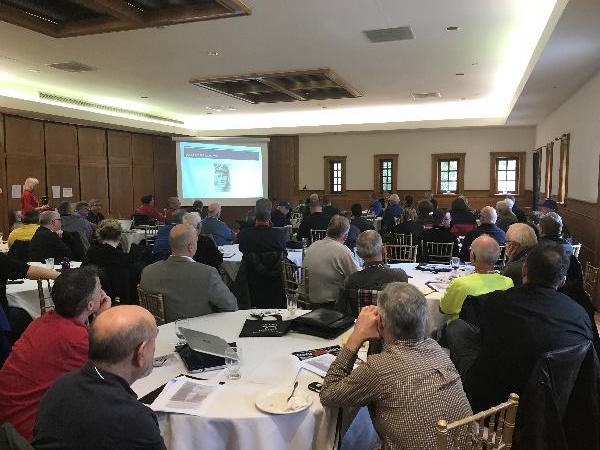2018 Canadian Baseball History Conference recap

By Andrew North
Some 70 cranks from Canada and the United States gathered on November 3-4, 2018, in London, Ontario, for the third annual Canadian Baseball History Conference. The Conference featured 14 half-hour research presentations, in addition to these special events:
- A tour of Labatt Park, the world’s oldest continuous use baseball park. Named Tecumseh Park when it opened for the 1877 International Association season, the park is still in use today by the London Majors Intercounty League team. The park is located at the forks of the Thames River, so that its seating offers a view across the river of the city’s skyline.
- A tour of the Middlesex County Courthouse, the Conference venue, a National Historic Site. Constructed between 1827 and 1829, it was reputedly modeled after Gothic-styled Malahide Castle, just north of Dublin, Ireland, the ancestral home of Colonel Thomas Talbot, whom the British had appointed overseer of the London region’s settlement. Our oak-panelled conference room featured a bank of windows looking directly across the river to Labatt Park. In fact, in several early images of baseball at the park the courthouse can be seen clearly.
- A 90-minute radio recreation (44 years before radio baseball!) of the championship game of the 1877 International Association season between the Tecumsehs of London and the Alleghenys of Pittsburgh. Star hurlers Fred Goldsmith and Pud Galvin faced one another at Tecumseh Park, outside our windows. Broadcast journalist Jim Van Horne provided the play-by-play, Bill Humber the colour commentary, and Chip Martin the on-field reportage. Andrew North’s post-game commentary emphasized the importance of this game to Canadian baseball’s historical development.
The half-hour sessions covered a variety of topics related to Canada’s baseball history:
- Heidi Jacobs discussed Chatham sports columnist Jack Calder, documentarian of the 1934 Chatham Coloured All-Stars, analyzing the literary aspects of his writing, and arguing that his nuanced approach worked toward breaking down racial barriers within Canadian sports.
- Stephen Dame spoke of baseball and the Canadian Armed Forces during World War II, as Canadian soldiers played in every theatre of war against fellow soldiers, civilians and their superior officers. He concluded his presentation by reading the names of all Canadian baseball players killed in action.
- Warren Campbell described mascots in Canadian baseball, from the Toronto Baseball Club’s Willie Hume in 1886 to the furry creatures of the modern minor and independent league teams. Included was a reference to the San Diego Chicken, a London boy who once operated the scoreboard at Labatt Park.
- Jon Dunkle described the Ontario League of 1930, a short-lived venture which resulted in a team with a losing record claiming the league championship.
- Andrew North interviewed Bruce Prentice, an important figure in the history of baseball in Canada. The founder of the Canadian Baseball Hall of Fame and Museum, Bruce enlightened as to how the Hall came to be, and its early triumphs and tribulations.
- Stephen Harding and Stephanie Radu, in a collaborative talk, outlined the variety of resources available to baseball researchers in London. Through examples, they explored ways in which these tools can be used to investigate players, teams, ballparks and sports facilities.
- Gary Gillette wrote of the ManDak League of the 1950s, a league of the northern prairies that took advantage of the surfeit of African-American talent following baseball’s reintegration. Gary was unable to attend due to a family issue, but his paper will be posted on-line (see below).
- Bob Barney analyzed the competing claims of Clinton and Pittsfield, Massachusetts, and of London and Labatt Park, for the distinction of the world’s oldest ballpark. This paper was followed immediately by the tour of Labatt Park.
- Dennis Thiessen outlined the pitching career of Tip O’Neill, before O’Neill thrived as a champion batsman. Emphasis was placed on O’Neill’s early years in Woodstock, Ontario.
- David Schulz described the depiction of baseball in postage stamps. Although Canada’s issuance of commemorative stamps received focus, the paper also answered such pressing questions as why did Ajman create a stamp for George Sisler in 1969, and why was Marty Cordova’s face on a 1999 Rwanda issue?
- Maxwell Kates outlined the birth of the Toronto Blue Jays franchise, chronicling how Toronto’s baseball dream became a reality. The paper represents a chapter in SABR’s forthcoming book Time for Expansion Baseball.
- Fred Toulch provided another in his series of Montreal Royals vignettes. He discussed the Montreal careers of Chuck Connors, Sandy Amoros, Tom Lasorda and Jackie Robinson, and illustrated that Al Gionfriddo could be considered a link to all of them.
- Tim Blaker presented an analysis of batting order positions of Canadian players through history. Using Retrosheet data from 1930, he noted the shifts from a preponderance of pitcher at-bats early, to a clustering of middle-of-the-order hitters in recent decades.
- Bill Humber provided a brief historical overview of baseball’s evolution, arguing that at every stage of baseball’s modernization there was Canadian content, from its early folk roots, to its continuity of play, to experiments with a unique regional variant.
Within the next few weeks, all presentations should be accessible via the web site of the Centre for Canadian Baseball Research at baseballresearch.ca.


